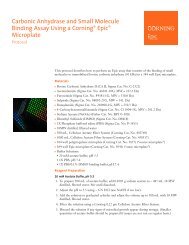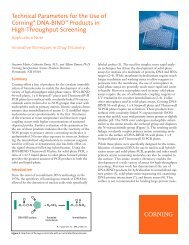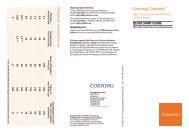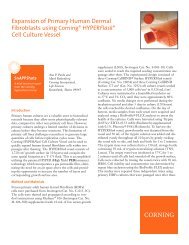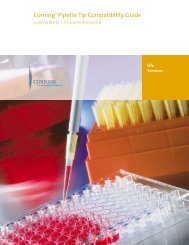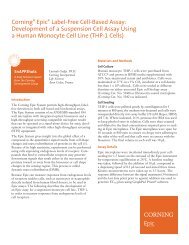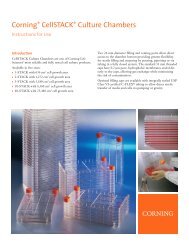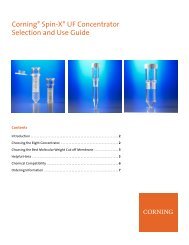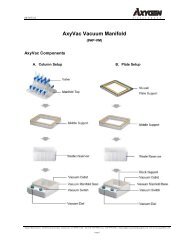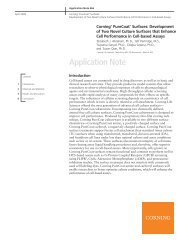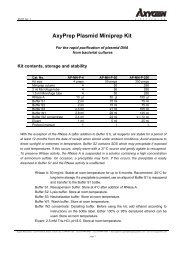Miniaturization of a Calcium Mobilization Assay in 384 Well Format
Miniaturization of a Calcium Mobilization Assay in 384 Well Format
Miniaturization of a Calcium Mobilization Assay in 384 Well Format
Create successful ePaper yourself
Turn your PDF publications into a flip-book with our unique Google optimized e-Paper software.
Life<br />
Sciences<br />
<strong>M<strong>in</strong>iaturization</strong> <strong>of</strong> a <strong>Calcium</strong> <strong>Mobilization</strong><br />
<strong>Assay</strong> <strong>in</strong> <strong>384</strong> <strong>Well</strong> <strong>Format</strong><br />
SnAPPShots<br />
A brief report<br />
from the Corn<strong>in</strong>g<br />
Applications Group<br />
Yu Alice Gao and Debra Hoover<br />
Introduction<br />
<strong>Calcium</strong> mobilization assays are frequently used to <strong>in</strong>vestigate G-prote<strong>in</strong> couple receptor<br />
(GPCR) and ligand <strong>in</strong>teractions and to screen library compounds or drug candidates that<br />
<strong>in</strong>teract with GPCR targets. Currently, these assays are predom<strong>in</strong>antly performed <strong>in</strong> a<br />
<strong>384</strong> well format with total volumes rang<strong>in</strong>g from 50 to 100 µL.<br />
In this study, we show a calcium mobilization assay that has been m<strong>in</strong>iaturized to 25 to<br />
40 µL us<strong>in</strong>g a new <strong>384</strong> well low volume (LV) black clear bottom (BCB) microplate from<br />
Corn<strong>in</strong>g.The results demonstrate that the quality <strong>of</strong> the data and assay performance on<br />
this LV microplate are comparable to that obta<strong>in</strong>ed from <strong>384</strong> well normal volume (NV)<br />
microplates.<br />
Material and Methods<br />
Transfected CHO-K1 cells (M1WT2 from ATCC, CRL-1984) were used <strong>in</strong> this study.<br />
This cell l<strong>in</strong>e over expresses rat M1 muscar<strong>in</strong>ic acetylchol<strong>in</strong>e receptor at the level <strong>of</strong><br />
~370 fmole <strong>of</strong> receptor prote<strong>in</strong> per mg <strong>of</strong> membrane prote<strong>in</strong>.<br />
Corn<strong>in</strong>g ® <strong>384</strong> well LV BCB microplates (Cat. No. 3542) allow for assay volumes rang<strong>in</strong>g<br />
from 5 to 50 µL. The microplates have a well bottom area <strong>of</strong> 0.032 cm 2 , roughly half that<br />
<strong>of</strong> the NV <strong>384</strong> well microplates, and are FLIPR ® (Molecular Devices, Inc.) compatible.
The LV microplates were seeded at 5,000 cells per well <strong>in</strong> 10 µL medium (HAMs F-12<br />
with 10% FBS and 50 µg/mL g418). All cultures were grown overnight <strong>in</strong> a humidity<br />
controlled <strong>in</strong>cubator with 5% CO 2 at 37°C. A calcium mobilization assay was then performed<br />
with these cultures us<strong>in</strong>g a <strong>Calcium</strong> 3 kit (Molecular Devices, Inc.). The procedure<br />
was as follows: After the addition <strong>of</strong> 10 µL calcium dye solution to wells conta<strong>in</strong><strong>in</strong>g cells,<br />
the microplates were <strong>in</strong>cubated for 30 m<strong>in</strong> <strong>in</strong> a humidity controlled <strong>in</strong>cubator with 5%<br />
CO 2 at 37°C. The microplates were then equilibrated to room temperature for 30 m<strong>in</strong><br />
before be<strong>in</strong>g loaded <strong>in</strong>to a Flexstation ® reader (Molecular Devices, Inc.). The fluidic<br />
module on the FlexStation was programmed to transfer 5 µL Carbachol solution to<br />
<strong>in</strong>duce the calcium response or 5 µL <strong>of</strong> pla<strong>in</strong> buffer for negative controls. F<strong>in</strong>al volume<br />
<strong>of</strong> each well was 25 µL. On NV microplates, cell seed<strong>in</strong>g density was doubled (10,000<br />
cells per well <strong>in</strong> 20 µL medium). Volumes were 20 µL for calcium dye and 10 µL for<br />
Carbachol. F<strong>in</strong>al volume was 50 µL per well.<br />
The calcium signal was monitored over a period <strong>of</strong> 1 m<strong>in</strong> at Excitation and Emission<br />
wavelengths <strong>of</strong> 485 and 525 nm.<br />
Results<br />
The performance <strong>of</strong> LV microplates was compared to NV microplates <strong>in</strong> three metrics.<br />
First was the time-dependent calcium flux k<strong>in</strong>etics upon the addition <strong>of</strong> Carbachol solution.<br />
As shown <strong>in</strong> Figure 1, the calcium flux responses were very similar between cells<br />
grown on LV and NV microplates. These responses were rapid and consistent over all<br />
the experiments conducted. Because <strong>of</strong> reduced cell numbers and reagent volumes, the<br />
overall signal strength on the LV microplate was reduced, with a signal to background<br />
ratio <strong>of</strong> 18 to 20. The signal to background ratio from NV microplates was 25 to 30.<br />
Nevertheless, the assay w<strong>in</strong>dow from the LV microplates was still statistically sound and<br />
such reduction did not affect overall performance <strong>of</strong> the assay as demonstrated below.<br />
The second metric compared <strong>in</strong> this study was the dose response curve to the agonist<br />
Carbachol. As shown <strong>in</strong> Figure 2, the dose response curve and estimated EC 50 to<br />
carbachol stimulation were very similar between LV and NV microplates.<br />
60000<br />
50000<br />
+ Carbachol (10 µM)<br />
or buffer<br />
120000<br />
100000<br />
+ Carbachol (10 µM)<br />
or buffer<br />
40000<br />
80000<br />
RFU<br />
30000<br />
RFU<br />
60000<br />
40000<br />
20000<br />
LV microplate<br />
20000<br />
NV microplate<br />
10000<br />
0 10 20 30 40 50 60<br />
0 10 20 30 40 50 60<br />
Time (sec.)<br />
Time (sec.)<br />
Figure 1. Comparison <strong>of</strong> time-dependent calcium mobilization upon the addition <strong>of</strong> Carbachol. The k<strong>in</strong>etic<br />
response obta<strong>in</strong>ed from the LV plate is very similar to that from NV plate, although the overall signal<br />
strength and background is reduced on the LV plate.
40000<br />
80000<br />
LV microplates<br />
NV microplates<br />
30000<br />
60000<br />
Max – M<strong>in</strong> (RFU)<br />
20000<br />
Max – M<strong>in</strong> (RFU)<br />
40000<br />
10000<br />
20000<br />
EC 50 = 100 nM<br />
EC 50 = 93 nM<br />
0<br />
0<br />
-9.5 -8.5 -7.5 -6.5 -5.5 -4.5 -9.5 -8.5 -7.5 -6.5 -5.5 -4.5<br />
Log [Carbachol]<br />
Log [Carbachol]<br />
Figure 2. Comparison <strong>of</strong> the dose response curve between the LV and the NV microplates. The estimated<br />
EC 50 from the LV microplate for Carbachol was equivalent to that obta<strong>in</strong>ed from the NV microplate.<br />
Each data po<strong>in</strong>t was the average <strong>of</strong> five replicates.<br />
F<strong>in</strong>ally, an analysis <strong>of</strong> the across-plate performance was exam<strong>in</strong>ed and is presented <strong>in</strong><br />
Table 1. The results showed that the across-plate variation for the LV microplates was<br />
smaller compared to that for the NV microplates, result<strong>in</strong>g <strong>in</strong> an enhanced overall assay<br />
performance on the LV microplates (expressed as Z').<br />
Table 1. Overall performance comparison <strong>of</strong> the calcium mobilization assay on the<br />
LV and the NV microplate<br />
Maximal Signal (RFU) Background (RFU) Z'<br />
LV plate 26040 (+3647) 1335 (+389) 0.51<br />
NV plate 46783 (+7986) 1778 (+415) 0.44<br />
Numbers are the average and standard deviation from 96 replicates (one quadrant).<br />
Conclusions<br />
◗ Corn<strong>in</strong>g ® <strong>384</strong> well low volume black clear bottom microplates (Cat. No. 3542) perform<br />
well <strong>in</strong> a calcium mobilization assay. All three performance metrics (calcium response<br />
k<strong>in</strong>etics, pharmacological pr<strong>of</strong>ile <strong>of</strong> a known agonist for the receptor, and Z') for the<br />
LV microplates are comparable to normal volume microplates.<br />
◗ The <strong>384</strong> well low volume black clear bottom microplates <strong>of</strong>fer significant reagent<br />
sav<strong>in</strong>gs (50%) as well as reduced cell preparation work and are ideal for m<strong>in</strong>iaturization<br />
<strong>of</strong> cell based assays <strong>in</strong> the <strong>384</strong> well format.
Corn<strong>in</strong>g Incorporated<br />
Life Sciences<br />
45 Nagog Park<br />
Acton, MA 01720<br />
t 800.492.1110<br />
t 978.635.2200<br />
f 978.635.2476<br />
www.corn<strong>in</strong>g.com/<br />
lifesciences<br />
Worldwide<br />
Support Offices<br />
ASIA<br />
Australia<br />
t 61 2-9416-0492<br />
f 61 2-9416-0493<br />
Ch<strong>in</strong>a<br />
t 86 21-3222-4666<br />
f 86 21-6288-1575<br />
Hong Kong<br />
t 852-2807-2723<br />
f 852-2807-2152<br />
India<br />
t 91 11 341 3440<br />
f 91 11 341 1520<br />
Japan<br />
t 81 (0) 3-3586 1996/1997<br />
f 81 (0) 3-3586 1291/1292<br />
Korea<br />
t 82 2-796-9500<br />
f 82 2-796-9300<br />
S<strong>in</strong>gapore<br />
t 65 6733-6511<br />
f 65 6861-2913<br />
Taiwan<br />
t 886 2-2716-0338<br />
f 886 2-2716-0339<br />
EUROPE<br />
France<br />
t 0800 916 882<br />
f 0800 918 636<br />
Germany<br />
t 0800 101 1153<br />
f 0800 101 2427<br />
The Netherlands<br />
& All Other<br />
European Countries<br />
t 31 (0) 20 659 60 51<br />
f 31 (0) 20 659 76 73<br />
United K<strong>in</strong>gdom<br />
t 0800 376 8660<br />
f 0800 279 1117<br />
Corn<strong>in</strong>g is a registered trademark <strong>of</strong> Corn<strong>in</strong>g Incorporated, Corn<strong>in</strong>g, NY.<br />
Discover<strong>in</strong>g Beyond Imag<strong>in</strong>ation and Flame <strong>of</strong> Discovery design are trademarks <strong>of</strong> Corn<strong>in</strong>g Incorporated, Corn<strong>in</strong>g, NY.<br />
FLIPR is a registered trademark <strong>of</strong> Molecular Devices, Inc., xxx,<br />
Flexstation is a registered trademark <strong>of</strong> Molecular Devices, Sunnyvale, CA.<br />
Corn<strong>in</strong>g Incorporated, One Riverfront Plaza, Corn<strong>in</strong>g, NY 14831-0001<br />
LATIN AMERICA<br />
Brasil<br />
t (55-11) 3089-7419<br />
f (55-11) 3167-0700<br />
Mexico<br />
t (52-81) 8158-8400<br />
f (52-81) 8313-8589<br />
© 2005 Corn<strong>in</strong>g Incorporated Pr<strong>in</strong>ted <strong>in</strong> USA 7/05 POD CLS-AN-068



